Embarking on day trips from Frankfurt by train opens a tapestry of experiences, weaving through the heart of Germany’s rich cultural landscapes, historic towns, and breathtaking natural beauty. Frankfurt, often celebrated for its modern skyline—a rare sight in traditionally picturesque Germany—serves not just as a financial powerhouse but as a strategic starting point for adventurers and explorers alike. This vibrant city, located on the banks of the Main River, offers more than just a gateway to the rest of Europe; it is a doorway to an array of day-trip destinations that promise to enrich your understanding and appreciation of German heritage, cuisine, and natural splendor.
The convenience of train travel in Germany cannot be overstated. With a highly efficient and widespread rail network, Deutsche Bahn (DB) offers seamless, comfortable, and punctual services to almost every nook and cranny of the country. Trains whisk you away from the hustle and bustle of Frankfurt’s Main Hauptbahnhof (central station) to serene landscapes and historic cities in under an hour in many cases. This mode of travel is not just about the destinations but the journeys themselves—gazing out at the changing scenery, from the dense forests of the Taunus mountains to the gentle rolling hills of the Rhine Valley, each view from the train window tells a story of Germany’s diverse geography and history.
The allure of exploring Germany by train from Frankfurt also lies in the sheer variety of destinations accessible within a day’s journey. Imagine starting your morning with a coffee at one of Frankfurt’s bustling cafes, and by midday, you’re stepping onto the cobblestone streets of a medieval town or sipping Riesling at a vineyard along the Rhine. These day trips offer not just a change of scenery but a deep dive into Germany’s soul, from the romantic ruins of Heidelberg Castle to the baroque splendor of Würzburg’s Residenz. Each destination showcases a facet of German culture and history, be it through its architecture, art, or culinary delights.
Moreover, train travel champions sustainability, a principle dearly held by many in today’s eco-conscious society. Opting for the train over car travel reduces carbon emissions, supports local economies, and encourages responsible tourism. It’s a way to explore Germany’s beauty while preserving it for future generations.
Beyond the environmental benefits, the cultural immersion and convenience offered by train travel from Frankfurt are unparalleled. Ticketing options cater to a range of budgets and travel preferences, including day passes (Ländertickets) that allow for unlimited travel within certain regions, making it possible to explore multiple destinations in a single day. Furthermore, the experience of traveling by train in Germany is to embrace a cherished part of German culture itself—the punctuality, the efficiency, and the communal spirit of sharing a journey with locals and fellow travelers.
Heidelberg: A Romantic Escape
Heidelberg represents the quintessence of romanticism in Germany, a city where poetry seems to linger in the air, and history is etched into every cobblestone. Located along the Neckar River, with the ruins of the Heidelberg Castle towering above, this city offers a picturesque blend of scenic beauty and rich cultural heritage. Heidelberg’s allure has captivated hearts for centuries, making it an indispensable day trip from Frankfurt by train. The journey itself is a prelude to the city’s charm, with trains gliding through landscapes that transition from the bustling modernity of Frankfurt to the tranquil beauty of the Neckar Valley.
Heidelberg Castle and the Old Town
Before delving into the seven must-see sites, it’s crucial to appreciate the crown jewels of Heidelberg: its iconic castle and the Old Town. Heidelberg Castle, or Heidelberger Schloss, is a monument to the epochs it has survived through, offering a tangible connection to the Renaissance and the times before. Perched on the Königstuhl hillside, it provides a commanding view of the city and the Neckar River, serving as a majestic backdrop that defines Heidelberg’s skyline. Though partly in ruins, the castle’s red sandstone walls and the grace of its Renaissance architecture continue to tell tales of grandeur and destruction, love and loss.
Descending from the castle to the Old Town, visitors step into a world that seems suspended in time. The Hauptstraße, one of Europe’s longest pedestrian shopping streets, runs through the heart of the Old Town, flanked by historic buildings, cozy cafes, and boutique shops. The Old Bridge (Alte Brücke), another of Heidelberg’s landmarks, arches gracefully over the Neckar, offering postcard-perfect views and a sense of serenity that contrasts with the vibrant life of the town.
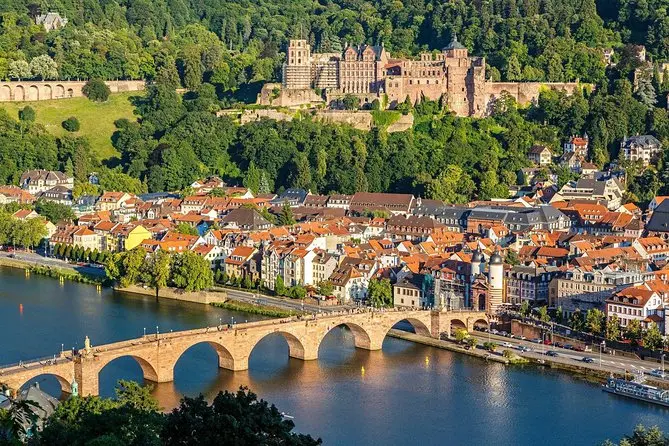
Source: Vlator
Philosophenweg (Philosopher’s Walk)
A path that has inspired poets, philosophers, and thinkers for centuries, the Philosophenweg winds along the northern banks of the Neckar River, opposite the Old Town. This trail offers unparalleled views of the Heidelberg Castle, the Old Bridge, and the river, especially enchanting at sunset. The walk is not just a visual treat but a journey through a landscape that has been a muse to many.
The Old University and Student Prison
The University of Heidelberg, established in 1386, is Germany’s oldest university and a pinnacle of Renaissance education. Within its historic walls, the Old University hosts the Alte Aula, a grandiose hall that has witnessed centuries of academic ceremonies. Nearby, the Student Prison (Studentenkarzer) offers a quirky glimpse into student life from 1823 to 1914, where students were confined for minor infractions, leaving behind graffiti that tells tales of youthful rebellion.
Karl Theodor Bridge (Old Bridge)
The Karl Theodor Bridge, known simply as the Old Bridge, is an 18th-century stone bridge that connects the Old Town to the eastern banks of the Neckar. Adorned with sculptures and offering breathtaking views of the castle and the river, the bridge is a beloved symbol of Heidelberg. The bridge gate, part of the city’s medieval fortifications, stands as a testament to Heidelberg’s historical strategic importance.
The Church of the Holy Spirit (Heiliggeistkirche)
Dominating the Marktplatz, the Church of the Holy Spirit is an imposing Gothic structure with a history as complex as the city itself. Since its foundation in the 14th century, it has been a shared place of worship for both Protestants and Catholics, a rarity. Its interiors are as impressive as its history, with magnificent stained-glass windows and the tomb of Elector Ruprecht III, the founder of Heidelberg University.
Königstuhl Funicular (Bergbahn)
To fully appreciate Heidelberg’s scenic beauty, a ride on the Königstuhl Funicular is essential. Starting from the Kornmarkt in the Old Town, the funicular ascends to the castle, continuing up to the Königstuhl mountain. The journey offers panoramic views of Heidelberg and the Neckar Valley, unfolding the city’s beauty as the landscape stretches towards the horizon.
Heidelberg Zoo
A visit to the Heidelberg Zoo offers a delightful diversion from the historical and architectural wonders of the city. Home to over 1,000 animals and a variety of species, the zoo is committed to conservation and education, providing a fun and informative experience for visitors of all ages.
The Neckarwiese
The Neckarwiese, a sprawling parkland along the banks of the Neckar River, is Heidelberg’s communal backyard. It’s a place where locals and visitors alike come to relax, picnic, and enjoy leisure activities.
With the castle as a backdrop and the river flowing gently by, the Neckarwiese encapsulates the spirit of Heidelberg—a blend of natural beauty, historical depth, and a vibrant sense of community.
Rhine Valley: A Journey through Time
The Rhine Valley, a storied ribbon of land and water that carves its way through the heart of Germany, offers a journey back in time to an era when knights, castles, and legends shaped the landscape. This region, recognized for its breathtaking natural beauty and rich cultural heritage, has been an inspiration for poets, painters, and dreamers throughout the ages. Embarking on a day trip from Frankfurt by train or by cruising the Rhine River presents travelers with two unique vantage points to experience the magic of the Rhine Valley, each offering its own narrative of this enchanting region.
Cruising the Rhine versus Train Views
Cruising the Rhine offers an immersive journey into the heart of the Rhine Valley. From the deck of a riverboat, travelers witness the unfolding panorama of steep vineyards, ancient fortresses, and picturesque villages that dot the riverside. The pace of river travel allows for a leisurely appreciation of the scenery, providing a sense of connection to the river that has been the lifeblood of this region for centuries. Cruises often include commentary, offering insights into the history and legends of the landmarks that slip past, making the journey a rich tapestry of stories and sights.
In contrast, taking the train along the Rhine Valley presents a different perspective. The train route, often hugging close to the river’s edge, offers sweeping views of the Rhine that alternate rapidly, like snapshots capturing the essence of the valley. From the comfort of a train carriage, passengers gaze out at landscapes that blend quickly from one majestic scene to the next, making every turn a new discovery. The train journey combines the thrill of exploration with the convenience of modern travel, allowing for quick stops at various towns along the way, making it possible to step directly from the realm of observation into the heart of the Rhine Valley’s history and culture.
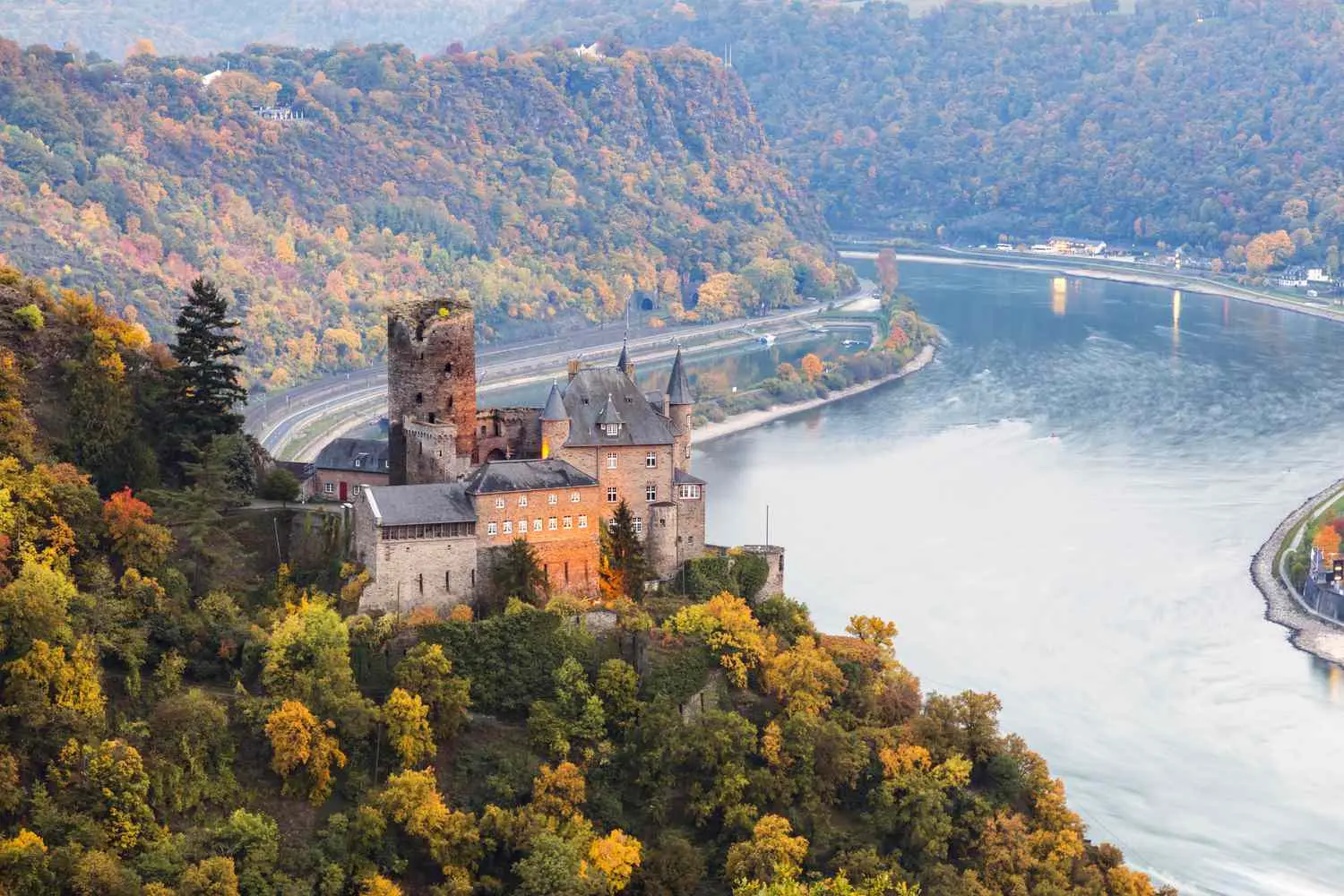
Source: TripSavvy
Highlights of Lorelei Rock and Medieval Towns
Lorelei Rock stands as a sentinel over one of the narrowest and deepest parts of the Rhine. Soaring 132 meters above the river, this slate rock is the subject of a famous legend that has been immortalized in poems, songs, and tales. According to lore, a beautiful siren named Lorelei, heartbroken and betrayed, threw herself into the Rhine from this rock and was transformed into a nymph who lured sailors to their doom with her haunting song. The echo of her name and her story adds a mystical layer to the already dramatic landscape, making a visit to Lorelei Rock a must for anyone journeying through the Rhine Valley.
The Rhine Valley is dotted with medieval towns that seem to have leaped from the pages of a storybook, each with its own character and history. Bacharach, with its timber-framed buildings and cobbled lanes, feels like stepping back into the Middle Ages. The town’s defensive walls and the ruins of Stahleck Castle speak of its past strategic importance and offer spectacular views of the surrounding vineyards and the river below.
St. Goar, located directly opposite Lorelei Rock, is another gem along the Rhine. Home to Rheinfels Castle, the largest fortress along the river, St. Goar is a testament to the Rhine Valley’s turbulent past. The castle’s sprawling ruins invite exploration, with underground tunnels and a museum that narrates the history of the region.
Rüdesheim am Rhein is famed not only for its vineyards but also for the Drosselgasse, a narrow alley lined with wine taverns and shops that embody the hospitable spirit of the Rhineland. The town’s Seilbahn (cable car) offers a ride up to the Niederwald Monument, providing breathtaking views of the vineyards, the river, and the towns beyond.
Koblenz, where the Rhine meets the Moselle River, is rich in cultural monuments and historic sites. The Ehrenbreitstein Fortress, accessible via a cable car across the Rhine, offers panoramic views of the confluence of the two rivers and the town below. The Deutsches Eck (German Corner), with its monumental equestrian statue of Emperor Wilhelm I, marks the point of unity between the Rhine and Moselle.
Würzburg
A Franconian GemWürzburg, found in the heart of Germany’s Franconia region, is a city where the past and present blend seamlessly, creating a tapestry rich with cultural heritage, architectural marvels, and vinicultural excellence. This Franconian gem, easily accessible from Frankfurt by train, offers travelers an enchanting glimpse into both the grandeur of German baroque architecture and the deeply rooted traditions of wine-making that have flourished in this fertile valley for centuries.
Koblenz: Where Rivers Meet
Koblenz, a city where the Rhine and Moselle rivers converge, is a place of convergence in more ways than one. It is here that natural beauty, historical depth, and architectural grandeur come together, creating a tapestry of experiences that captivates visitors from near and far. Located at this strategic junction, Koblenz has been a witness to and a participant in the unfolding history of Europe for over two millennia. A day trip from Frankfurt by train brings travelers to this unique city, where the waters meet and stories of the past are etched into the landscape.
The Confluence of the Rhine and Moselle
The meeting of the Rhine and Moselle rivers, known as the “Deutsches Eck” or German Corner, is more than just a geographical highlight; it’s a symbolic representation of unity and strength. The confluence is marked by a monumental equestrian statue of Emperor Wilhelm I, which stands as a guardian overlooking the waters. This spot offers panoramic views of the two rivers blending into one another, a sight that has inspired poets, painters, and dreamers throughout the ages.
Visiting the Deutsches Eck provides not only breathtaking views but also a sense of the historical significance of Koblenz. The city’s name, derived from the Latin “confluentes,” meaning “where the rivers meet,” underscores its importance as a military and trade hub since ancient times. Today, the confluence is a place of peace and unity, where visitors can stroll along the promenades of both rivers, enjoying the tranquility and beauty of the surroundings.

Source: Wikipedia
Ehrenbreitstein Fortress via Cable Car
Dominating the city’s skyline from the opposite bank of the Rhine is the Ehrenbreitstein Fortress, a testament to Koblenz’s strategic importance through the centuries. This formidable fortress, one of the largest and oldest in Europe, has been a silent witness to the ebb and flow of power, from the days of the Holy Roman Empire to the conflicts of the 19th and 20th centuries. Today, it stands as a monument to the resilience and endurance of Koblenz.
Reaching the fortress is an adventure in itself, best experienced through the Koblenz cable car ride, which is the longest in Germany over water. The cable car journey offers an aerial perspective of the city, the confluence of the rivers, and the fortress, providing a unique vantage point that is both exhilarating and enlightening. As you ascend, the panorama of Koblenz unfolds beneath you, a landscape painted with the greens of the riverside parks and the reds and whites of the city’s buildings, all set against the backdrop of the flowing waters.
The fortress also serves as a cultural venue, hosting exhibitions, concerts, and events that breathe contemporary life into its ancient walls. The gardens and open spaces within the fortress grounds provide a serene escape, inviting visitors to linger and soak in the views, the history, and the tranquility of this remarkable site.
Trier: A Walk through Ancient Rome
Trier, Germany’s oldest city, situated along the banks of the Moselle River, is a living museum of ancient Roman civilization. A day trip from Frankfurt by train transports you to a time when Trier, or Augusta Treverorum as it was known, stood as a prominent city in the vast Roman Empire. Today, Trier invites visitors on a journey through its ancient streets, where Roman monuments stand as testaments to its glorious past. Among these historic treasures, the Black Gate, or Porta Nigra, looms as a colossal guardian of history, embodying the architectural brilliance and enduring legacy of Roman engineering.
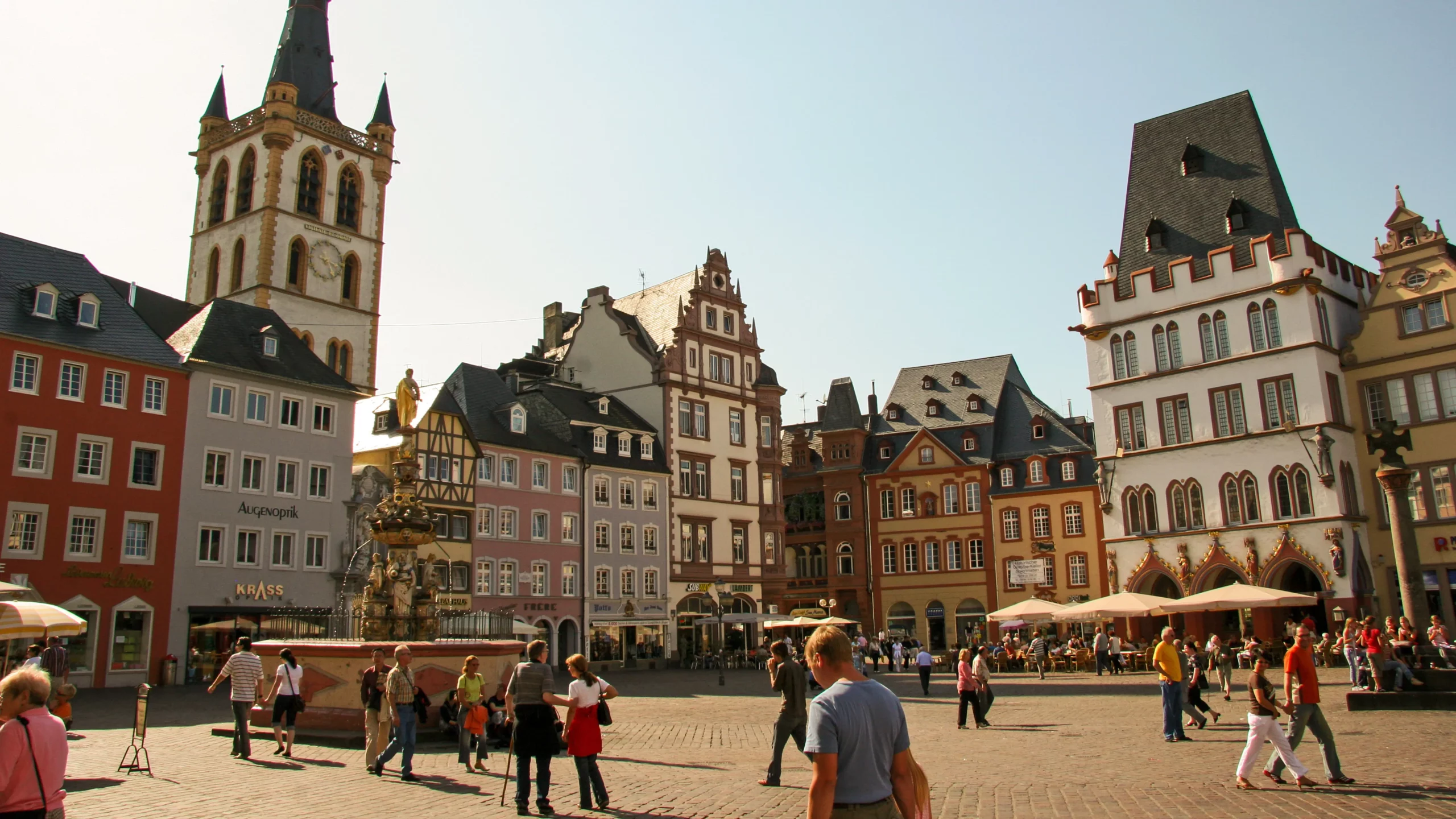
Source: Rick Steves Europe
A Walk through Ancient Rome
Trier’s Roman heritage unfolds in a series of architectural marvels, each narrating a chapter from the city’s storied past. The city’s layout, with its ancient roads leading to the central forum, echoes the grand urban planning of Rome, designed for both practicality and majesty. Walking through Trier is akin to traversing the pages of a history book, where each monument invites awe and reflection.
The Trier Imperial Baths, once among the largest in the Roman Empire, offer a glimpse into the sophisticated lifestyle of its ancient inhabitants. The ruins reveal a complex system of furnaces and water channels, illustrating the Romans’ advanced understanding of engineering and their penchant for luxury. Today, visitors can explore the subterranean tunnels beneath the baths, a labyrinth that once served as the foundation for this grand complex.
The Amphitheater of Trier, another marvel of Roman architecture, could seat up to 20,000 spectators, eager to watch gladiatorial combats and animal fights. This ancient entertainment venue, carved into the hillside, retains its imposing structure, allowing visitors to imagine the cheers and roars that once filled the air.
The Basilica of Constantine, a colossal hall that served as the throne room of Emperor Constantine, stands as a testament to the city’s political importance in Roman times. Its awe-inspiring dimensions and the survival of its massive roof structure, the largest surviving single-room structure from Roman times, speak to the architectural ingenuity of its builders.
The Black Gate (Porta Nigra)
The Porta Nigra, the most iconic of Trier’s Roman monuments, guards the city’s northern entrance. This massive gate, constructed without the use of mortar, its stone blocks held together by iron clamps, is a marvel of Roman military architecture. Its name, Latin for “Black Gate,” derives from the darkened color of its sandstone, aged through centuries. The Porta Nigra stands as a silent witness to Trier’s Roman past, its scars from weather and war telling tales of resilience and endurance.
A visit to the Porta Nigra is not merely an encounter with ancient architecture; it is a step back into a time when Trier was a bustling metropolis of the Roman Empire. Guided tours offer insights into the gate’s construction, its strategic importance, and its transformation over the centuries, including a period when it served as a church. Climbing to the upper levels, visitors are rewarded with panoramic views of Trier, a cityscape that blends ancient grandeur with modern vitality.
Bamberg: A Town of Breweries and Canals
Bamberg, a picturesque town in Bavaria, Germany, is a place where medieval charm and brewing traditions converge, creating a unique tapestry of cultural heritage. Recognized as a UNESCO World Heritage Site, Bamberg captivates visitors with its well-preserved old town, a maze of narrow streets, historic buildings, and quaint canals that draw comparisons to Venice. But it’s not just the visual appeal that makes Bamberg a must-visit; the town is also famous for its unique smoked beer, a local specialty that embodies centuries of brewing craftsmanship. A day trip from Frankfurt by train unfolds into an adventure through Bamberg’s storied lanes and breweries, offering a taste of its rich history and vibrant beer culture.
Exploring Little Venice and the Old Town
Bamberg’s old town, with its cobblestone streets and half-timbered houses, seems to have leaped straight out of a fairy tale. At the heart of this enchantment is “Little Venice,” a charming ensemble of fishermen’s houses from the 19th century, lining the banks of the Regnitz River. This picturesque quarter, with its narrow facades and colorful shutters, reflects the tranquil life of the town’s historic fishing community. Visitors can enjoy a leisurely walk along the river or take a boat tour to admire these beautiful homes from the water, capturing the essence of Bamberg’s Venetian nickname.
The Bamberg Cathedral, with its four imposing towers, stands as a beacon of the town’s medieval architecture and history. The cathedral is a testament to Bamberg’s spiritual and political significance through the centuries, housing the tomb of Pope Clement II, the only pope buried north of the Alps. The Old Town Hall, another architectural marvel, is perched on an island in the middle of the Regnitz River, its frescoes and rococo decorations a testament to Bamberg’s artistic heritage.
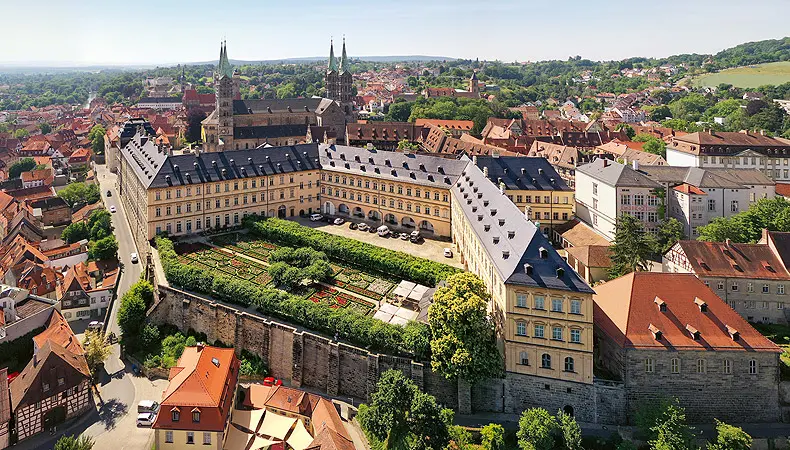
Source: Bayerische
Stepping into Schlenkerla is like stepping back in time, with its dark wood paneling, vaulted ceilings, and the pervasive aroma of smoked malt. Here, visitors can savor Rauchbier straight from the wooden barrel, accompanied by traditional Franconian dishes that complement the beer’s robust flavor.
Bamberg boasts several other breweries, each offering their own take on Rauchbier and other varieties, inviting visitors on a flavorful journey through the town’s brewing landscape. Beer gardens and brewery tours provide further insights into the art and science of beer making, showcasing Bamberg’s enduring legacy as a center of brewing excellence.
Fulda: A Baroque Surprise
Located in the heart of Germany, the city of Fulda offers a baroque surprise, an enchanting blend of grandeur and serenity that captures the imagination of all who visit. A day trip from Frankfurt by train unveils this hidden gem, where the majestic Fulda Cathedral stands as a testament to the city’s rich spiritual and architectural heritage, and the Palace Gardens offer a tranquil escape, a canvas of nature’s artistry shaped by human hands. Fulda, with its historical depth and scenic beauty, invites travelers to step into a world where the past is cherished and the present is embraced amidst baroque elegance.
The Majestic Fulda Cathedral
The Fulda Cathedral, a masterpiece of baroque architecture, dominates the cityscape with its imposing presence and intricate beauty. Built in the early 18th century, the cathedral serves as the spiritual heart of Fulda, a place of pilgrimage and reverence that has drawn visitors for centuries. The cathedral is dedicated to Saint Boniface, the “Apostle of the Germans,” whose tomb lies within its sanctified walls, making it a site of profound historical and religious significance.
Stepping inside the Fulda Cathedral, visitors are enveloped in an atmosphere of awe-inspiring solemnity and beauty. The interior is a spectacle of baroque artistry, with ornate frescoes, gilded stucco, and imposing marble columns that guide the eye towards the high altar. The light filtering through the stained glass windows bathes the space in a kaleidoscope of colors, illuminating the intricate details and enhancing the spiritual ambiance. The cathedral not only serves as a place of worship but also as a monument to the baroque era’s artistic and architectural achievements, a testament to the city’s historical importance in the spiritual and cultural landscape of Germany.
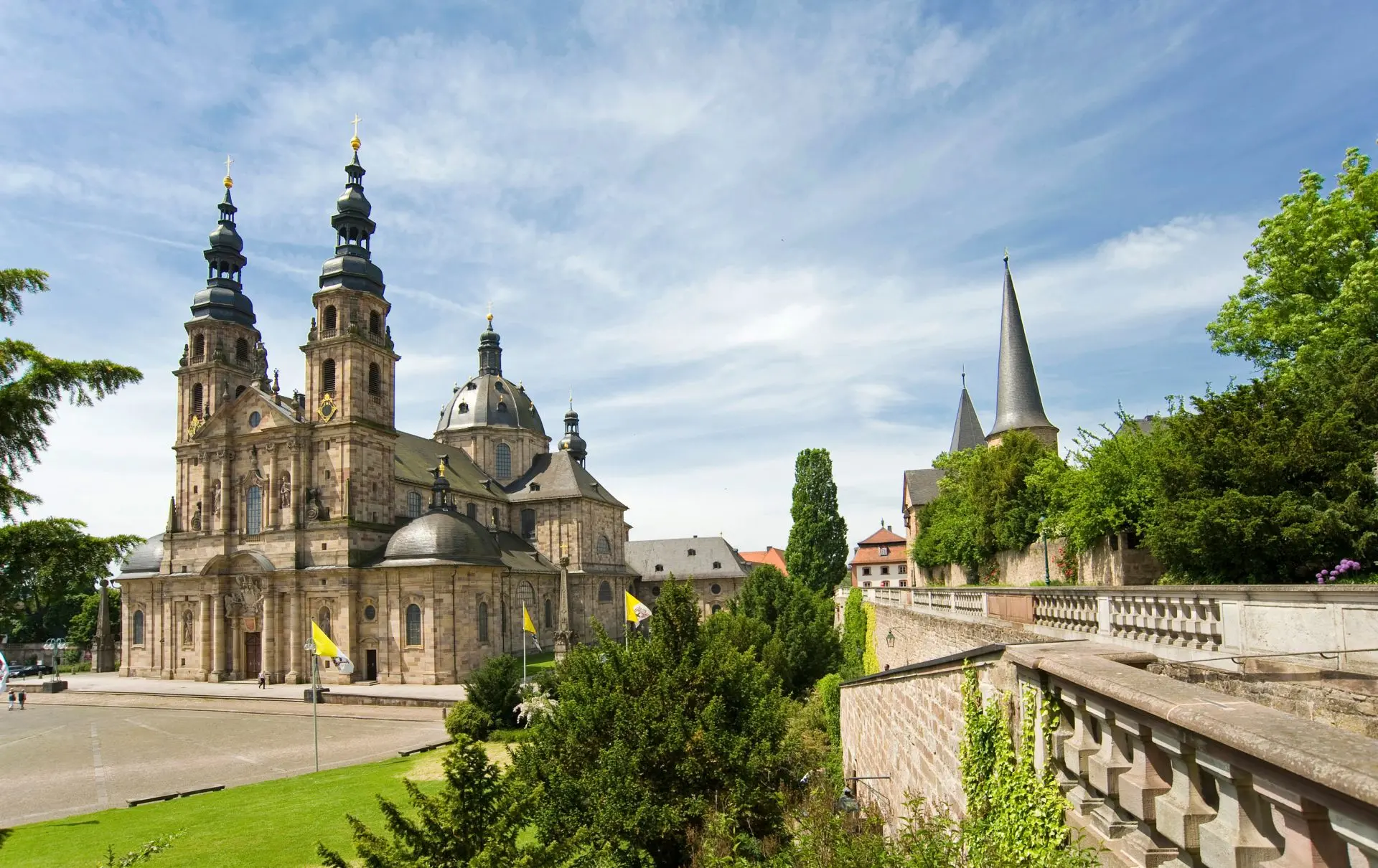
Source: Hessen Tourismus
Strolling through the Palace Gardens
Adjacent to the grandeur of the Fulda Cathedral, the Palace Gardens offer a contrasting experience of baroque elegance, a serene oasis that invites leisurely strolls and contemplation. Originally designed in the 18th century as part of the Fulda Palace complex, the gardens are a masterpiece of landscape architecture, embodying the baroque principles of symmetry, order, and beauty.
The Palace Gardens unfold in a series of meticulously manicured lawns, ornamental flower beds, and tree-lined avenues, creating a harmonious blend of nature and artifice. Sculptures and fountains dot the landscape, adding elements of surprise and delight. The Orangery, with its classical façade, serves as a focal point, hosting exhibitions and events that bridge the gap between past and present.
Walking through the Palace Gardens, visitors can appreciate the tranquility and beauty that these green spaces provide. Each path and hedge seems to tell a story, leading to secluded nooks and panoramic vistas that offer views of the Fulda Cathedral and the surrounding city. The gardens are not just a haven for nature lovers but a living museum, where the elegance and sophistication of the baroque era are preserved and celebrated in every leaf and stone.
Marburg
A Medieval Marvel, Marburg, perched on the banks of the Lahn River, is a tapestry of steep cobblestone streets, half-timbered houses, and the echoes of a medieval past that still whispers through its alleyways. A day trip from Frankfurt by train transports visitors to a town that seems suspended in time, where the spirit of the Middle Ages is preserved in its architecture and traditions. Marburg is not only renowned for its picturesque beauty but also as a cradle of education and storytelling, home to one of the oldest universities in the world and the haunts of the legendary Brothers Grimm. Climbing to the castle that crowns the city offers not just a physical ascent but a journey through the layers of history and culture that define this medieval marvel.
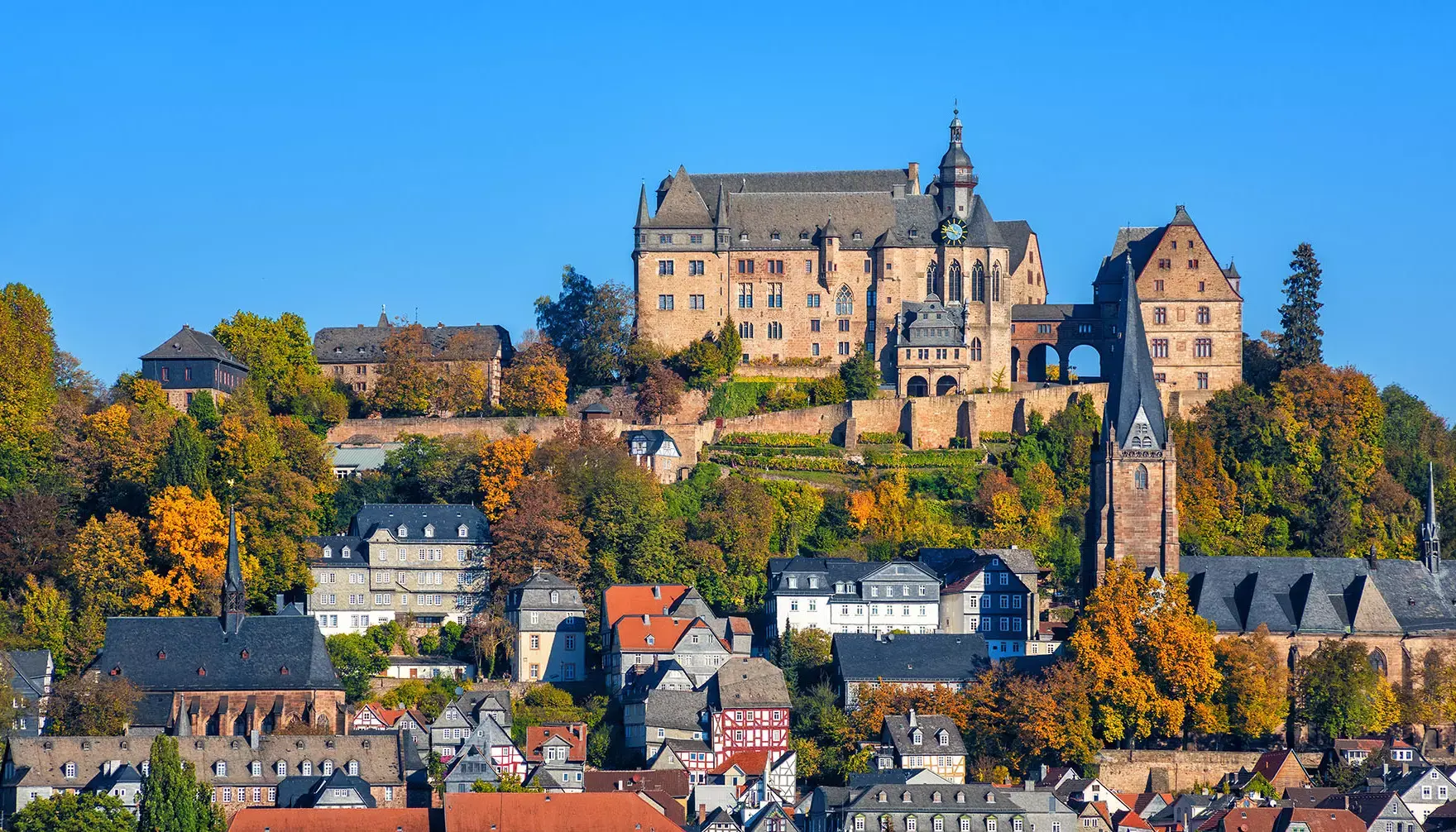
Source: Hessen Tourismus
The Historic University and the Brothers Grimm
The University of Marburg, founded in 1527 by Landgrave Philip I, holds the distinction of being the world’s first Protestant university. Its establishment marked a turning point in the intellectual and cultural landscape of Europe, attracting scholars and thinkers who would shape the course of history. The university’s buildings, scattered throughout the old town, are a testament to the enduring pursuit of knowledge and the spirit of academic freedom that has defined Marburg for centuries.
Among the luminaries associated with Marburg, none are perhaps as beloved as the Brothers Grimm, Jacob and Wilhelm. Students and later scholars at the university, the Grimms embarked on their monumental task of collecting and preserving German folktales right here, in the shadow of Marburg’s spires. The city’s enchanting atmosphere, with its medieval streets and fairy-tale architecture, undoubtedly inspired some of the timeless stories that would become their legacy. Today, visitors can trace the steps of the Brothers Grimm in Marburg, exploring the places where they lived, studied, and gathered the tales that would captivate generations.
Dominating the Marburg skyline is the Landgrafenschloss, the castle that has stood as a sentinel over the city since the 11th century. The climb to the castle, though steep, is a journey through Marburg’s medieval heart, with each step revealing views more breathtaking than the last. The path winds past ancient buildings and through narrow lanes, an ascent that mirrors the city’s layered history.
Bad Homburg: Spa Day Out
Bad Homburg vor der Höhe, located at the foot of the Taunus Mountains, is a sanctuary of wellness and history, renowned for its therapeutic springs and verdant Kurpark, a legacy of health and relaxation that dates back centuries. A day trip from Frankfurt by train unfolds into a retreat into tranquility and a journey into the past, where the healing waters of Bad Homburg have drawn visitors from near and far, seeking solace and rejuvenation. Beyond its reputation as a spa town, Bad Homburg harbors a rich historical tapestry, epitomized by the Saalburg Roman Fort, a gateway to the ancient world. In Bad Homburg, the serenity of nature meets the grandeur of history, offering a day out that nourishes both body and soul.
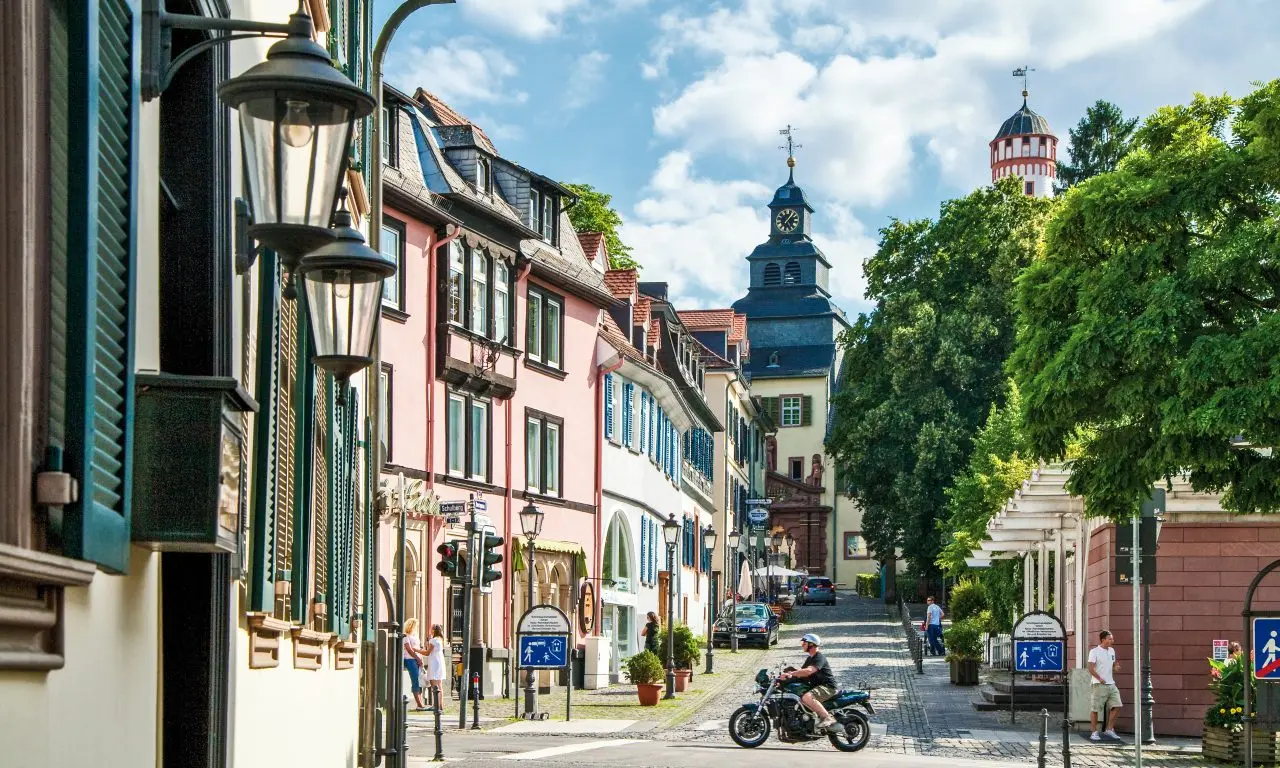
Source: Jumelage
Therapeutic Springs and the Kurpark
The heart of Bad Homburg’s spa culture is its therapeutic springs, whose mineral-rich waters have been celebrated for their healing properties since Roman times. The town’s fame as a spa destination was cemented in the 19th century when it became a fashionable resort for European royalty and aristocracy, drawn by the promise of health and wellness. Today, the springs continue to be a source of natural therapy, accessible through the town’s modern spa facilities, where visitors can indulge in treatments that blend tradition with contemporary wellness practices.
The Kurpark, a sprawling landscape garden that extends over 44 hectares, is the green lung of Bad Homburg, a masterpiece of landscape design that offers a peaceful escape from the hustle and bustle of daily life. Created in the 19th century, the park is a harmonious blend of English landscape gardening and traditional French formal gardens, featuring manicured lawns, picturesque ponds, and meandering paths that invite leisurely strolls. The Kurpark is not just a haven for relaxation but also a cultural venue, hosting concerts, exhibitions, and events that enrich the spa experience with artistic and musical delights.
Aschaffenburg: The Bavarian Nice
Aschaffenburg, affectionately dubbed “The Bavarian Nice” due to its mild climate and lush vegetation, is a city where the charm of Bavaria meets the elegance of the Mediterranean. A day trip from Frankfurt by train unveils this picturesque city on the banks of the Main River, offering a blend of cultural heritage, architectural marvels, and natural beauty. The city’s crown jewels, Johannisburg Castle and the Pompejanum, stand as testaments to Aschaffenburg’s rich history and artistic legacy. Moreover, the Main riverside provides a tranquil setting for leisure and contemplation, making Aschaffenburg a delightful escape from the hustle and bustle of everyday life.
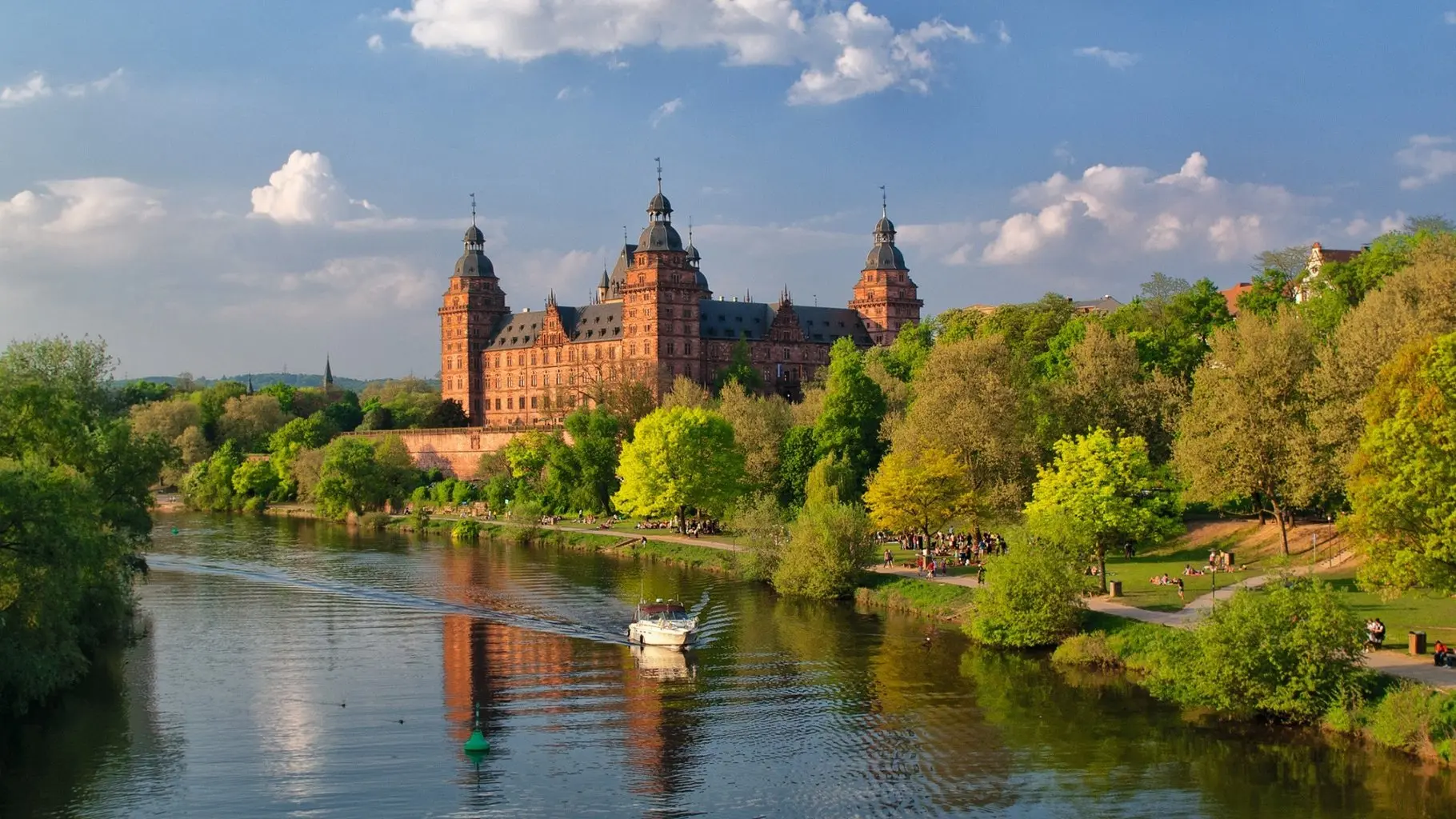
Source: German Travel
Johannisburg Castle and Pompejanum
Johannisburg Castle, constructed from red sandstone in the early 17th century, dominates the Aschaffenburg skyline with its imposing structure and picturesque location overlooking the Main River. The castle, one of the most significant Renaissance buildings in Germany, was the summer residence of the Electors of Mainz. Today, it welcomes visitors from around the world, inviting them to explore its vast halls, which house art collections, including masterpieces of the School of Lucas Cranach, and an architectural museum that showcases the castle’s history and restoration.
Adjacent to the castle, the Pompejanum is an intriguing architectural curiosity that transports visitors to ancient Italy. Commissioned by King Ludwig I of Bavaria and completed in 1848, the Pompejanum is a replica of a Roman villa from Pompeii, designed to offer a tangible experience of Roman domestic architecture and culture. The interior is adorned with frescoes and furnishings that replicate those found in Pompeii, providing a unique insight into the daily life of the Romans before the tragic eruption of Mount Vesuvius.
A Day at the Main Riverside
The Main River is the lifeblood of Aschaffenburg, a serene waterway that offers both picturesque views and a plethora of activities for visitors and locals alike. Strolling along the riverside promenades, one can enjoy the harmonious blend of natural beauty and urban sophistication that defines Aschaffenburg. The parks and green spaces that line the banks of the Main invite relaxation and recreation, from leisurely picnics under the shade of ancient trees to more active pursuits such as cycling and jogging along the scenic paths.
Boating on the Main is a popular way to experience the river’s tranquility and the city’s beauty from a different perspective. Whether it’s a leisurely paddle in a canoe or a more structured river cruise, the water offers unparalleled views of Aschaffenburg’s landmarks, including Johannisburg Castle, which stands majestically over the river, providing a stunning backdrop for photographs and memories.
The riverside also hosts various cafes and restaurants, where visitors can indulge in local and international cuisines while enjoying the view of the river flowing gently by. In the warmer months, these establishments spill out onto the banks, creating a lively atmosphere where the joys of good food, good company, and beautiful surroundings converge.
Day Trips from Frankfurt by Train – Bottom Line
Embarking from Frankfurt by train, travelers are invited on a journey through a mosaic of experiences that illustrate the diversity and richness of Germany’s landscape, culture, and history. This exploration beyond the city limits opens doors to medieval towns, baroque palaces, Roman fortresses, and tranquil spa retreats, each destination offering its own unique narrative and charm. Frankfurt, situated at the heart of Europe, serves as a gateway to these myriad adventures, where the convenience and efficiency of train travel allow for the discovery of the country’s treasures, often hidden just a short ride away.
The destinations we’ve journeyed through—from the romantic ruins of Heidelberg to the baroque elegance of Würzburg, from the ancient Roman history of Trier to the serene beauty of the Rhine Valley—highlight the tapestry of experiences that await those willing to explore. Each location, with its own distinct atmosphere and allure, contributes to a broader appreciation of what makes Germany unique. The architectural marvels, such as Johannisburg Castle in Aschaffenburg and the imposing Ehrenbreitstein Fortress in Koblenz, stand as testaments to the country’s rich historical heritage. Meanwhile, the natural beauty of places like the Taunus Mountains near Bad Homburg and the picturesque riversides of Marburg and Bamberg offers a tranquil escape from the urban hustle and bustle.
This journey beyond Frankfurt is not just about sightseeing; it’s about immersing oneself in the cultural fabric of each destination. Sampling Bamberg’s smoked beer, strolling through the Palace Gardens of Fulda, or contemplating the ancient Roman legacies at the Saalburg Fort near Bad Homburg are experiences that enrich the traveler’s understanding and appreciation of the local traditions and history. These excursions offer a taste of the regional diversity that defines Germany, encouraging a deeper engagement with the country’s culture beyond the stereotypical attractions.
Moreover, the ease with which these day trips can be undertaken by train underscores the accessibility and convenience of exploring Germany’s hidden gems. The German rail network serves as the veins through which the lifeblood of adventure and discovery flows, connecting Frankfurt with distant towns and landscapes. This connectivity not only makes travel efficient but also sustainable, contributing to a form of tourism that respects the environment and local communities.
In conclusion, day trips from Frankfurt by train showcase the multifaceted beauty of Germany, a country where history, culture, and nature intertwine in fascinating ways.



